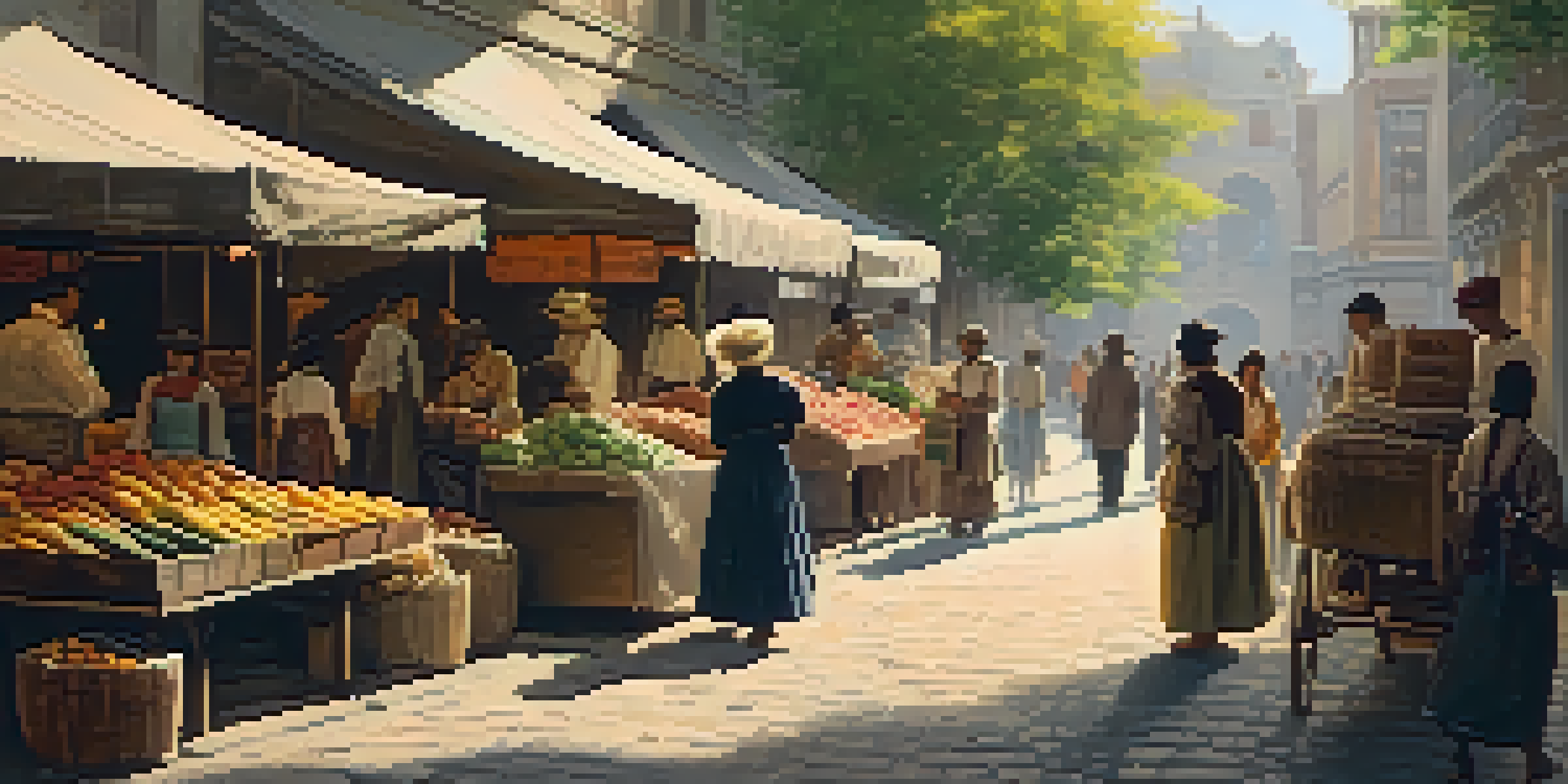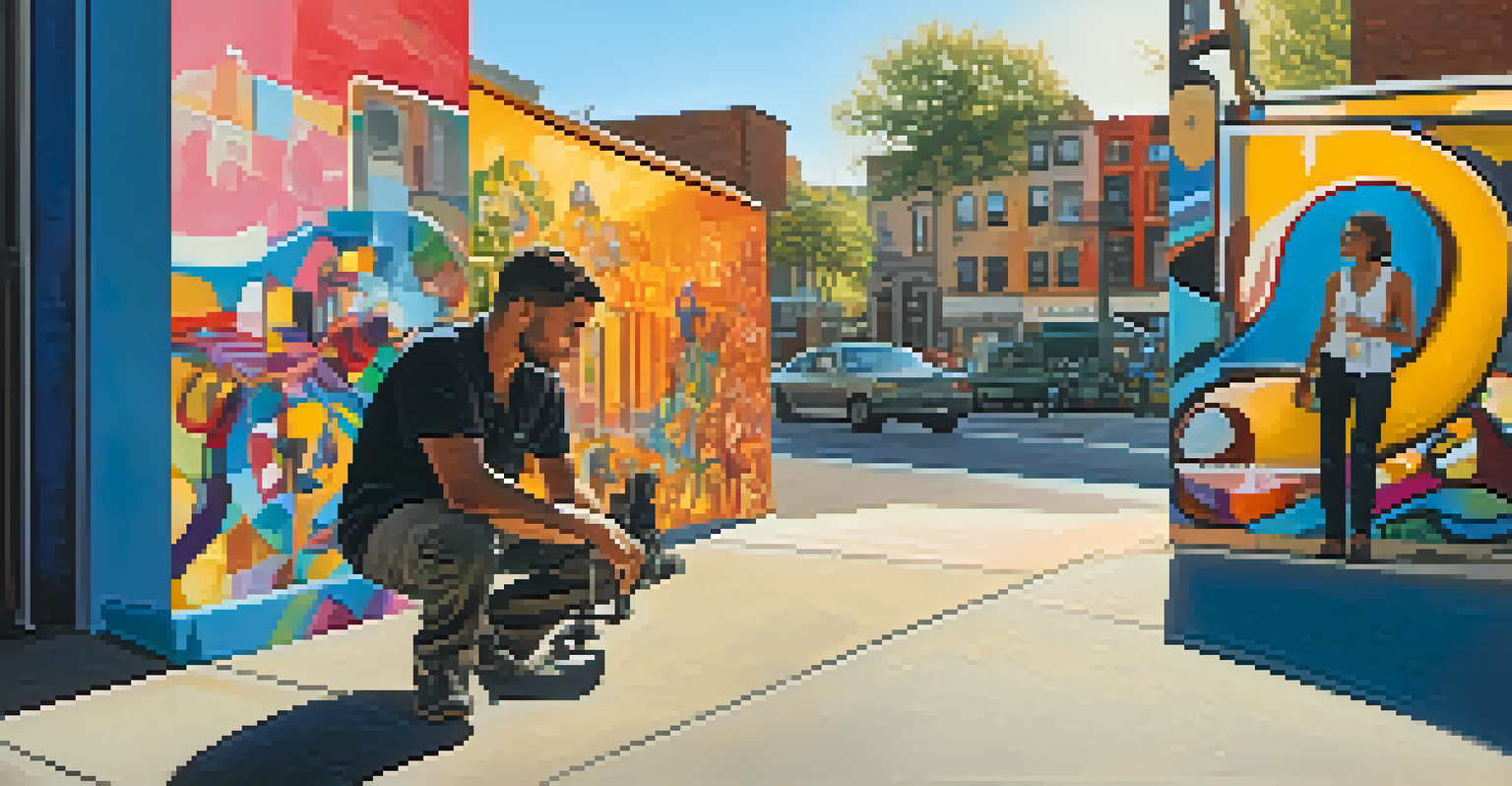The Evolution of Street Photography: Capturing Everyday Life

The Origins of Street Photography in the 19th Century
Street photography has its roots in the bustling streets of the 19th century, where early photographers sought to document the everyday lives of ordinary people. This genre emerged alongside the invention of portable cameras, which allowed photographers to capture spontaneous moments without the formalities of studio settings.
The best thing about a picture is that it never changes, even when the people in it do.
Pioneers like Eugène Atget and Henri Cartier-Bresson laid the groundwork for street photography by using their cameras to tell stories of urban life. They focused on candid moments that reflected the dynamics of society, from the joy of street vendors to the solemnity of city dwellers. Their work transcended mere documentation; it became a medium for social commentary.
The rise of street photography was a response to the rapid urbanization of cities during this period. As people flocked to urban centers seeking opportunities, photographers turned their lenses towards these vibrant environments, capturing the essence of human experience in the midst of change.
The Influence of the Leica Camera on Street Photography
The introduction of the Leica camera in the 1920s revolutionized street photography, offering a compact and discreet option that encouraged spontaneity. Photographers could now capture fleeting moments without drawing attention, allowing for more genuine expressions of life on the streets.

With its rangefinder design, the Leica allowed photographers to focus quickly and accurately, making it easier to shoot in dynamic environments. This innovation empowered artists like Robert Frank and Garry Winogrand, who embraced the camera's capabilities to capture raw, unfiltered moments.
Street Photography's Historical Roots
Street photography emerged in the 19th century, capturing the essence of urban life through spontaneous moments.
As a result, the Leica became synonymous with street photography, shaping the way photographers approached their craft. It marked a shift towards a more personal and subjective style, emphasizing the photographer's unique perspective on the world around them.
The Rise of Candid Photography in the Mid-20th Century
The mid-20th century saw a significant shift in street photography, with a growing emphasis on candid shots that highlighted the spontaneity of everyday life. Photographers like Vivian Maier and Joel Meyerowitz embraced this approach, capturing unposed moments that revealed the beauty and complexity of urban existence.
Photography is the story I fail to put into words.
This period also coincided with the rise of photojournalism, which influenced street photographers to document social issues and cultural changes. Their work often reflected broader societal themes, such as civil rights movements and urban decay, making street photography a powerful tool for storytelling.
Moreover, as photography became more accessible, a new generation of photographers emerged, each adding their unique voice to the genre. The candid style encouraged a sense of intimacy, inviting viewers to engage with the subjects and their environments in a more profound way.
Street Photography in the Digital Age
The advent of digital cameras and smartphones has transformed street photography, making it more accessible than ever. Today, anyone with a smartphone can capture and share moments from their daily lives, leading to an explosion of visual content on social media platforms.
Digital technology has also introduced new editing tools, allowing photographers to enhance their images and create striking visuals. This shift has encouraged experimentation and creativity, as artists blend traditional techniques with modern technology to push the boundaries of street photography.
Digital Age Transforms Street Art
The rise of digital technology and social media has made street photography more accessible but also challenges authenticity.
However, this democratization has also led to challenges, such as oversaturation and the struggle for authenticity. As the line between amateur and professional blurs, photographers must find ways to maintain their unique voice in a crowded digital landscape.
The Role of Social Media in Street Photography
Social media has played a pivotal role in the evolution of street photography, providing a platform for artists to showcase their work and connect with a global audience. Instagram, in particular, has become a popular space for photographers to share their street captures, fostering a sense of community and collaboration.
Through hashtags and online challenges, photographers can engage with one another and gain exposure for their work. This interconnectedness has led to the rise of diverse styles and perspectives, as artists from different backgrounds contribute their unique interpretations of street life.
However, the pressure to gain likes and followers can sometimes overshadow the artistic intent behind street photography. Balancing authenticity with the desire for recognition remains a challenge for many photographers navigating this digital landscape.
Street Photography as a Form of Social Commentary
Street photography has long served as a powerful medium for social commentary, capturing the essence of life in urban environments. Photographers often use their lenses to highlight social issues, such as inequality, gentrification, and cultural diversity, providing a visual narrative that sparks conversation.
By documenting the everyday experiences of individuals, street photographers can humanize complex societal issues. Their work invites viewers to empathize with subjects and reflect on the broader context of their lives, fostering a deeper understanding of the world around them.
Social Commentary Through Imagery
Photographers use street photography as a medium to highlight social issues and provoke thought about urban life.
This role as social commentators continues to be relevant today, as photographers respond to contemporary challenges and changes within society. Through their art, they not only capture moments but also inspire action and provoke thought among their audiences.
The Future of Street Photography: Trends and Innovations
As street photography continues to evolve, several trends and innovations are shaping its future. The integration of technology, such as drones and augmented reality, is providing new perspectives and opportunities for photographers to explore urban landscapes in innovative ways.
Additionally, the rise of virtual and augmented reality experiences allows audiences to engage with street photography in immersive formats. This shift will likely redefine how we perceive and interact with street art, blending visual storytelling with interactive elements.

Moreover, the ongoing dialogue around representation and inclusivity in photography is prompting artists to examine their own practices. As more diverse voices emerge, the future of street photography promises to reflect a richer tapestry of human experience, celebrating the complexity of everyday life.